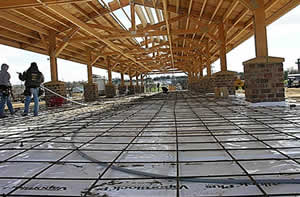

Webmaster: Stansfeld, LLC. |
|
|

FEBRUARY 2011 MEETING
Wednesday, February 16, 2011 (1.0 PDH)
TECHNICAL PROGRAM
Specifying Underslab Moisture or Gas Barriers
Speaker: Rod Aasheim, National Market Specialist, Raven Industries Engineered Films Division, Sioux Falls, SD, Tel. No. (800) 635-3456
Rod Aasheim is a National Market Specialist. He has earned his B.A. degree in Communications from Augustana College, Sioux Falls, SD. He has been with Raven for four years, working directly with a number of users of engineered poly products and architectural and engineering firms on a nationwide basis. He has a combined 17 years in construction and industrial supplies, and industrial packaging materials with two prior companies, Fastenal, Inc., and Cole, Inc. working in the states of Arkansas, Missouri, Kansas, Oklahoma, South Dakota, Nebraska, Iowa, and Minnesota.
PRESENTATION SUMMARY
 To an audience of about 65 at the HESS Club, Mr. Rod Aasheim presented information on synthetic membranes (High Performance Film and Sheeting) and their broad applications in the construction and other industries. He said that synthetic membranes are highly specialized to meet a variety needs and therefore should be properly specified by the engineer or architect. These membranes may be found below the foundation and as cladding around the exterior skin of the structure.
To an audience of about 65 at the HESS Club, Mr. Rod Aasheim presented information on synthetic membranes (High Performance Film and Sheeting) and their broad applications in the construction and other industries. He said that synthetic membranes are highly specialized to meet a variety needs and therefore should be properly specified by the engineer or architect. These membranes may be found below the foundation and as cladding around the exterior skin of the structure.
A vapor barrier is defined as an impermeable membrane designed to prevent moisture from migrating from the soil up through foundations in commercial buildings and residences. One of the most common applications is to prevent the transfer of moisture or gasses through a concrete slab on grade and into the conditioned interior space. This type of membrane must meet criteria specific to the job such as resilience, high puncture resistance, and very low moisture permeance. To reinforce the importance of a barrier below the slab, Mr. Aasheim presented data showing that an 1/8" diameter hole in a barrier can transmit 1.3 pounds or 20 ounces of water over a 100 square foot area in just 24 hours.
A gas barrier is an impermeable membrane designed to prevent soil gases such as radon, methane and volatile organic compounds (VOC's) from migrating from the soil through concrete and into the building or residence. Gas barriers contain multiple layers that incorporate specific resins designed to block and resist gases. A gas barrier may also be designed to block the migration of moisture.
Many of the products presented are available in a variety of types to meet the specific demands of any application and budget. Most of these products are readily available at builder supply outlets. The cost for many of these products is a very minor part of the total job and is cost competitive with the more common but ineffective products, many of which do not meet code requirements.
Additionally, the properly specified and installed product will greatly minimize damage in floor finishes such as blistering, loss of adhesion, mold and mildew, and condensation buckling. This reduction in damage to other materials and finishes will also reduce liability and call backs.
 |
 |
 |
|---|
For a copy of Mr. Aasheim's slide presentation, click here.
|



